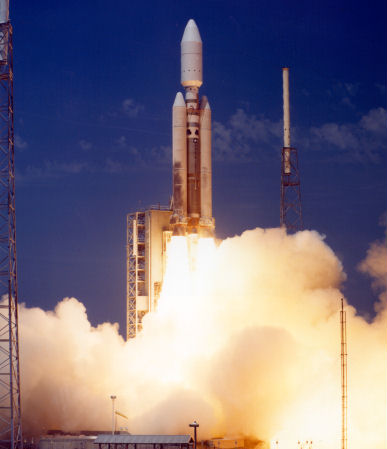TITAN IVB FACT SHEET
By Cliff Lethbridge

Titan IVB Launch, Photo Courtesy U.S. Air Force
Classification: Space Launch Vehicle
Length: 177 feet, 2 inches (with IUS upper stage)
Length: 187 feet, 2 inches (maximum with no upper stage)
Length: 207 feet, 2 inches (with Centaur upper stage)
Diameter: 10 feet (first and second stages)
Diameter: 16 feet, 8 inches (payload fairing)
Date of First Cape Canaveral Launch: February 23, 1997
Date of Final Cape Canaveral Launch: April 29, 2005
Number of Cape Canaveral Launches: 13
After 19 Titan IV launches from Cape Canaveral and 7 Titan IV launches from Vandenberg Air Force Base, California, an improved version called the Titan IVB was introduced in early 1997. The Titan IVB increased payload capability by 25 percent over previous Titan IV rockets, which were subsequently renamed Titan IVA. Although nearly identical to the Titan IVA in other respects, the Titan IVB introduced upgraded solid rocket motors manufactured by Alliant Techsystems, a company which had just recently purchased booster designer Hercules Aerospace Products. Each three-segment solid rocket motor upgrade (SRMU) was 112.4 feet tall by 10.5 feet wide. The solid rocket motors, which burned HTPB solid propellant, could each produce a thrust of 1,700,000 pounds. First stage thrust of the Titan IVB was improved to 547,100 pounds. Upgraded electronics and guidance, standard vehicle interfaces and new Programmable Aerospace Ground Equipment (PAGE) also enhanced Titan IVB performance over the Titan IVA.
Like the Titan IVA, the Titan IVB could employ a Centaur upper stage, an Inertial Upper Stage (IUS) or no upper stage. With the introduction of the SRMU, specific vehicle payload capacity was improved as follows:
Version 401: Maximum 12,700 pounds
Version 402: Maximum 47,000 pounds
Version 403: Maximum 38,800 pounds
Version 404: Maximum 36,700 pounds
Version 405: Maximum 49,000 pounds
The first Titan IVB was launched from Cape Canaveral Launch Complex 40 on February 23, 1997 and carried a Defense Support Program (DSP) missile detection satellite for the Department of Defense. This maiden flight of the Titan IVB marked the first time a Cape-launched military Titan mission was declassified. In a change from previous policy, both the nature of the payload and the launch time were made public prior to launch.


